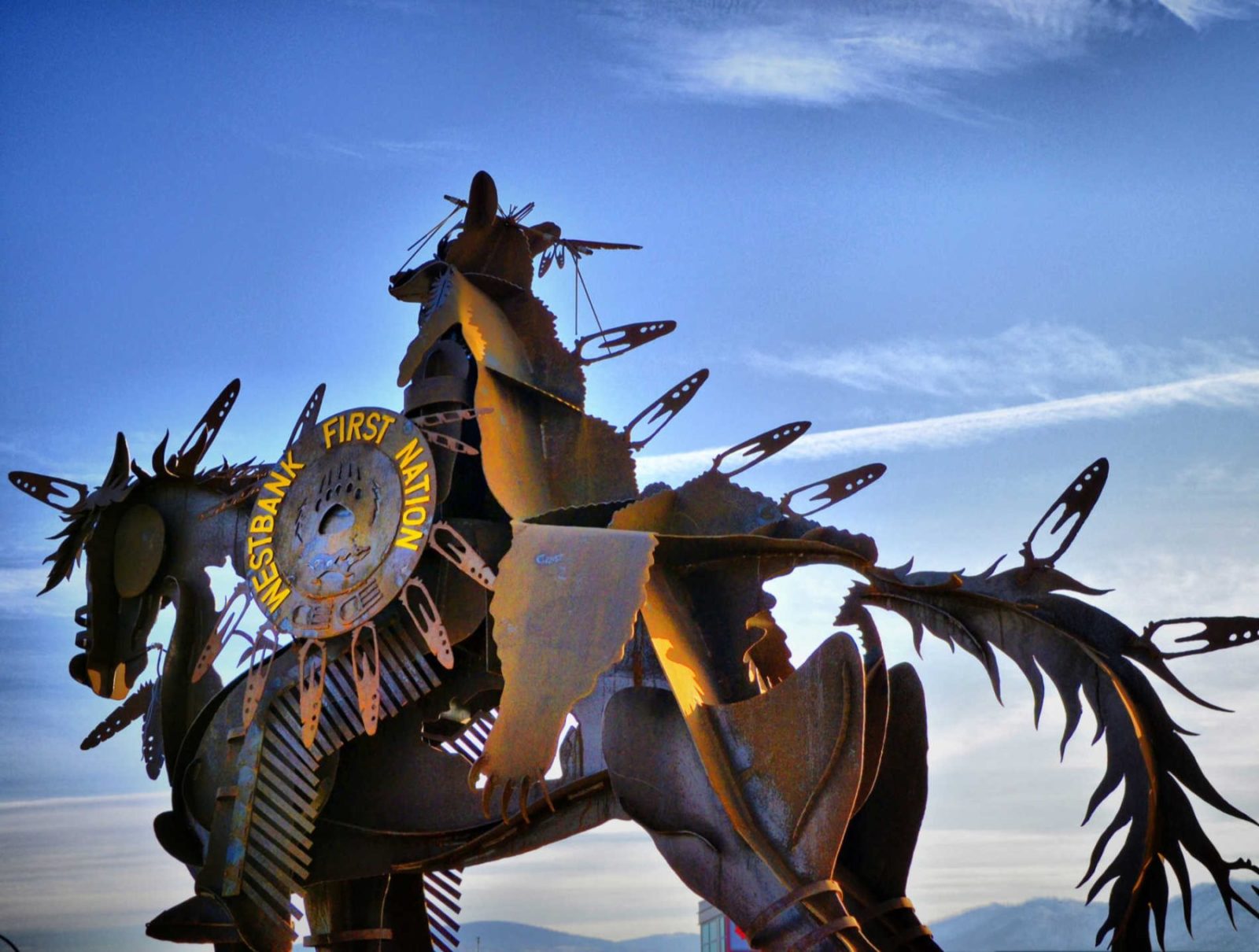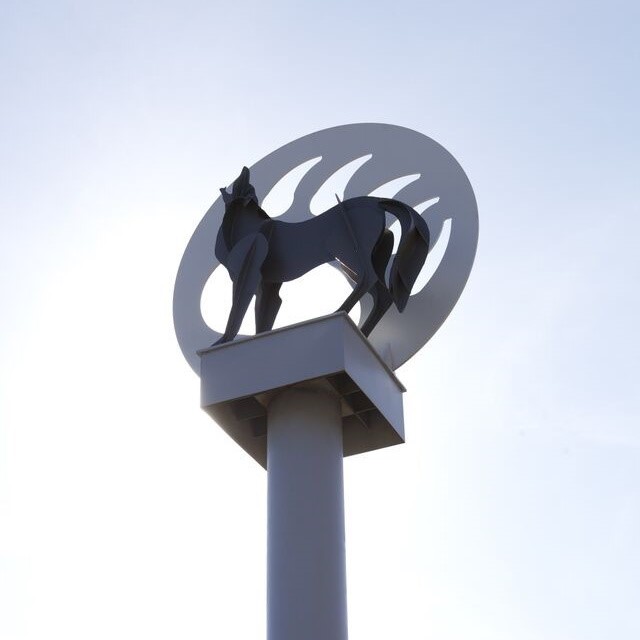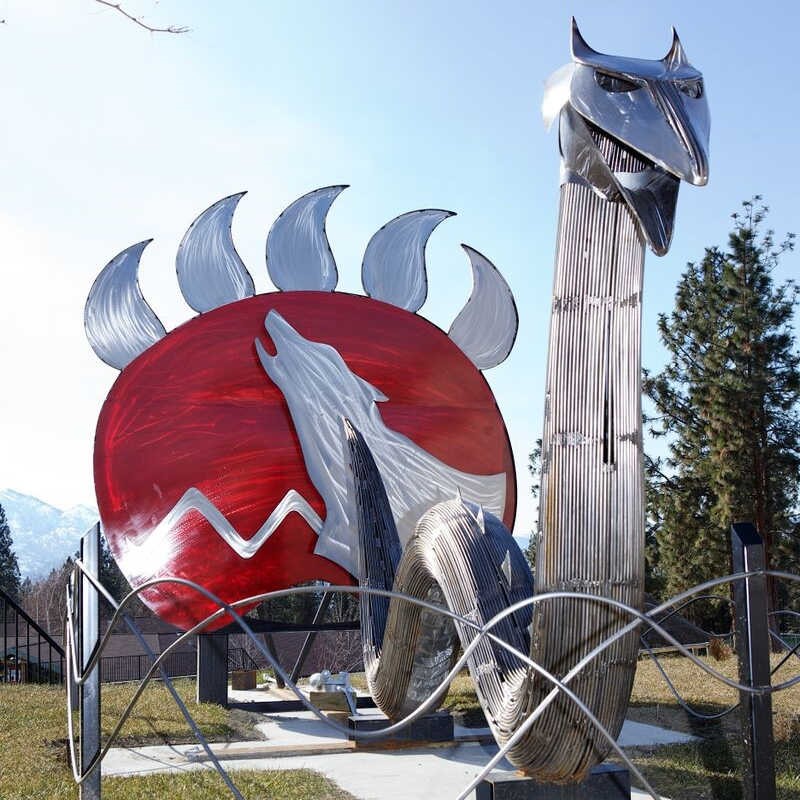
Local Indigenous Art: Sculptures and Murals
The Westbank First Nation Public Art Committee (PAC) established the WFN Public Art Program in September 2014. The Program is a collaborative, collective, creative process between WFN, practicing artists, and community members. Public art creatively addresses the needs and aspirations of the WFN community while also acknowledging WFN and syilx/Okanagan heritage.
Below you will find information about each of these public art pieces and we invite you to take a self guided tour to see them all in person!
Medicine Bear (2011)
Artist: Smoker Marchand | 3604 Carrington Road (snyatan Shopping Centre)
Artist statement: “The bear was strong medicine because he was the strongest and most powerful of the animal people and known for his courage and protectiveness. There is nothing more dangerous than a bear protecting its family, which I believe is a symbol of First Nation efforts to bring life and a healthy environment to our community.”
sen’klip (Coyote) (2013)
Artist: Smoker Marchand | Campbell Road roundabouts
These two monuments, found on either side of William R. Bennett Bridge entrance, showcase a coyote and grizzly bear paw. sen’k’lip (coyote) was sent by k̓ʷuləncútn (Creator) to help our people survive on this land. A plaque at the site states: “The Okanagan people are observers of the beauty of nature, and active participants in the protection of this area. The Okanagan people used this place as a village and lake crossing for thousands of years.”
Elk (2013)
Artist: Smoker Marchand | 2180 Elk Road
For centuries, those who successfully hunted elk were recognized as important leaders of traditional practices. Quite often, the best hunters, or those whose families were great hunters, have been recognized as those fortunate enough to adorn the porcelain teeth of the elk.
Veterans Memorial (2014)
Artist: Smoker Marchand | 1900 Quail Lane
Approximately 7,000 Indigenous people served in the Canadian Armed Forces during the First and Second World Wars. This monument honours both Westbank First Nation veterans and all who have served, and continue to serve, in the Canadian and American Armed Forces. Artist statement: “I wanted to show a strong Indian man. I wanted to show a strong Indian woman. And I wanted to show a soldier who could be any soldier— he could be Native, he could be any soldier—because I think it’s important to represent all our people. My uncle said that when they got into the trenches, they were a band of brothers. There was no colour. There was no difference in who they were. They fought together, and I think that’s really important.”
Four Food Chiefs Medallions (2010)
Artist: Janine Lott| 1900 Quail Lane
The Four Food Chiefs, Chief siyaʔ (saskatoon berry), Chief sp’iƛ̓ləm (bitterroot), Chief ntityix (spring salmon), and Chief skəmxist (black bear), represent various protocols, social order and life lessons that traditionally guided the way of life of the syilx people prior to outside contact.
3-D WFN Logo Monument (2010)
Artist: Clint George | 1900 Quail Lane
This sculpture features elements of the WFN logo, which captures the essence of syilx teachings, culture, and history: sen’klip, the trickster and teacher; kiláwnaʔ; nx̌aʔx̌ʔitkʷ; and Okanagan Lake.
qʷac̓iʔ (Pit House)
1900 Quail Lane
qʷac̓iʔ were traditionally used during the winter months, utilizing geothermal energy, the warmth of the mother earth, to keep the people safe. They were well kept, as they were more than a resting place; they were also a space to share stories and celebrate. When spring arrived, the syilx people would travel with portable summer tule mat dwellings / tukʷta̓nilx
Turtle Island, Four Food Chiefs (2011)
Artist: Clint George | 1920 Quail Lane
This monument depicts Turtle Island, the Four Food Chiefs, and the four elements of water, earth, wind, and fire. Turtle represents a peaceful, liberated society, providing compassion for all, and brings vision, knowledge, and peace to the people.
nx̌aʔx̌ʔitkʷ (2013)
Artist: Smoker Marchand | 525 Hwy 97 (Okanagan Lake Shopping Centre)
The sacred spirit of the lake, nx ̌aʔx̌ʔitkʷ, lives in the water but can also move to the land and air. nx ̌aʔx̌ʔitkʷ reminds us to be mindful of our resources; if nx ̌aʔx̌ʔitkʷ disappears due to pollution and misuse of the water, so do the plants, medicines, trees, and foods that sustain us.
Harmonizing Mother Earth (2004)
Artist: Graham Pettman | 515 Hwy 97 South (WFN Government Office)
Graham Pettman is known for intertwining nature and spirit in his artwork. This piece intertwines the Creator with Mother, Child, Bear, Eagle, Coyote, Mouse, nx ̌aʔx̌ʔitkʷ, and Drum.
Community Reader Board (2013)
Artist: Clint George | 1902 Pheasant Lane
The digital reader board, framed by public art, contains rotating notices that help share information about community events and initiatives. The sculpture depicts Chief siyaʔ, one of the Four Food Chiefs.
Learn more about Westbank First Nation and local Indigenous Culture.